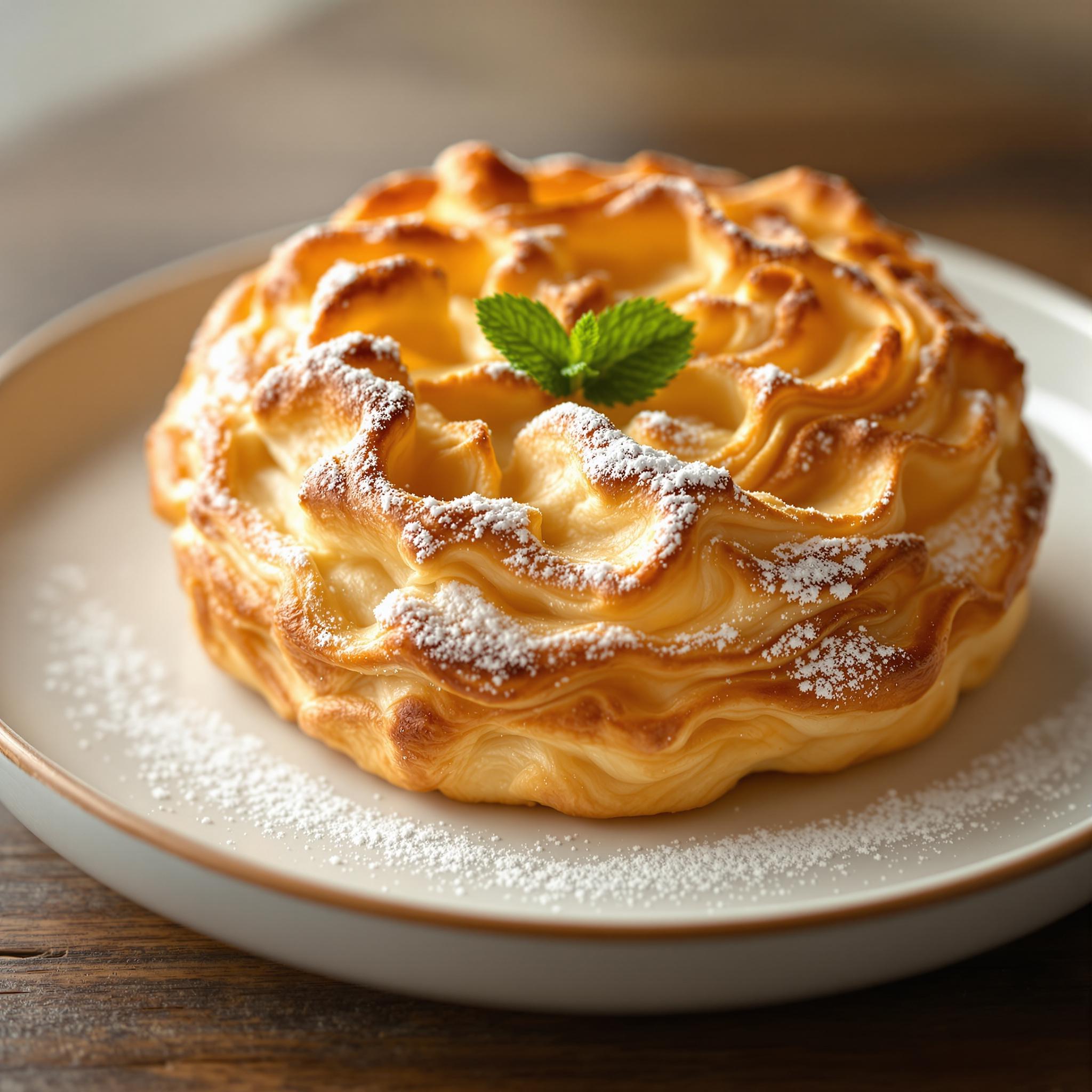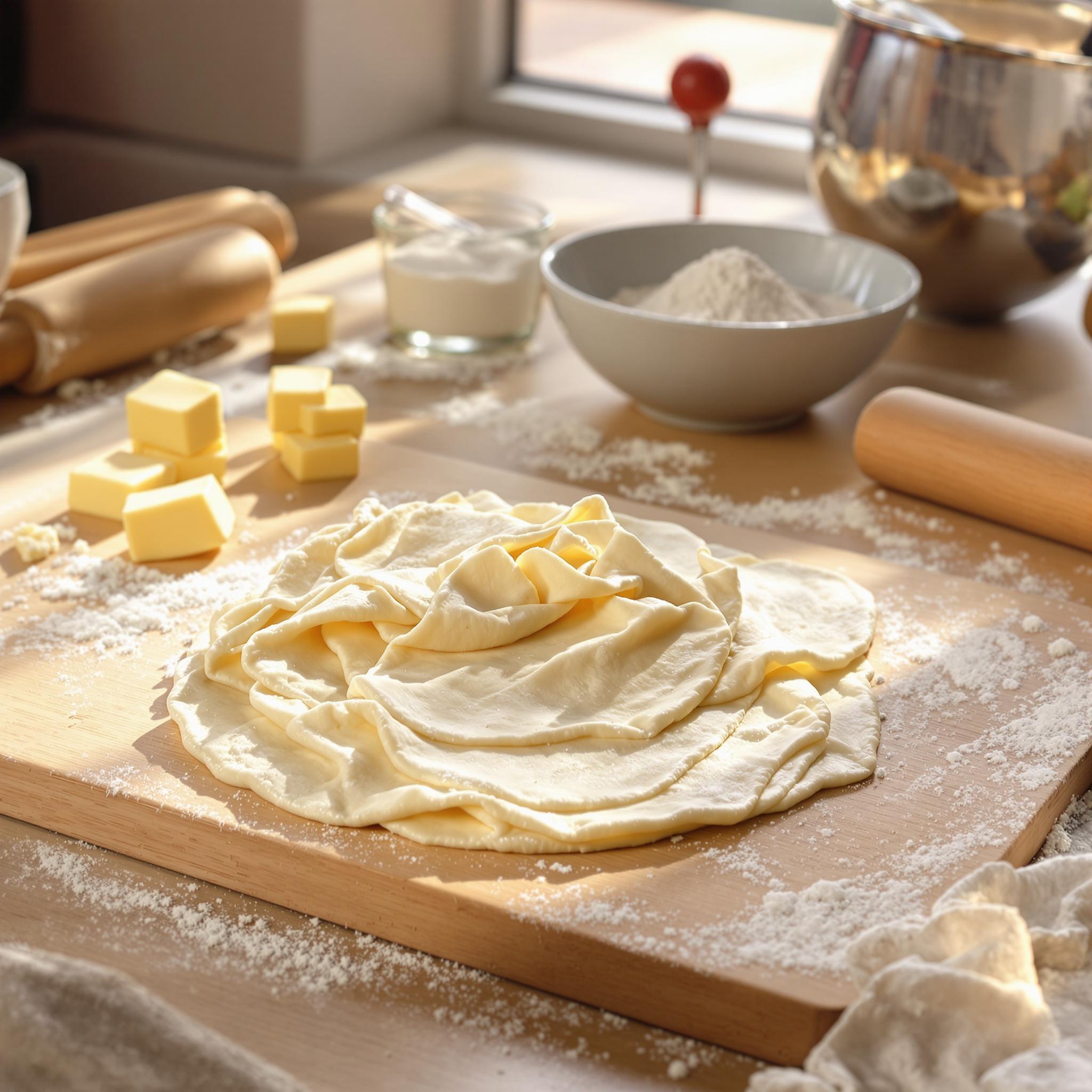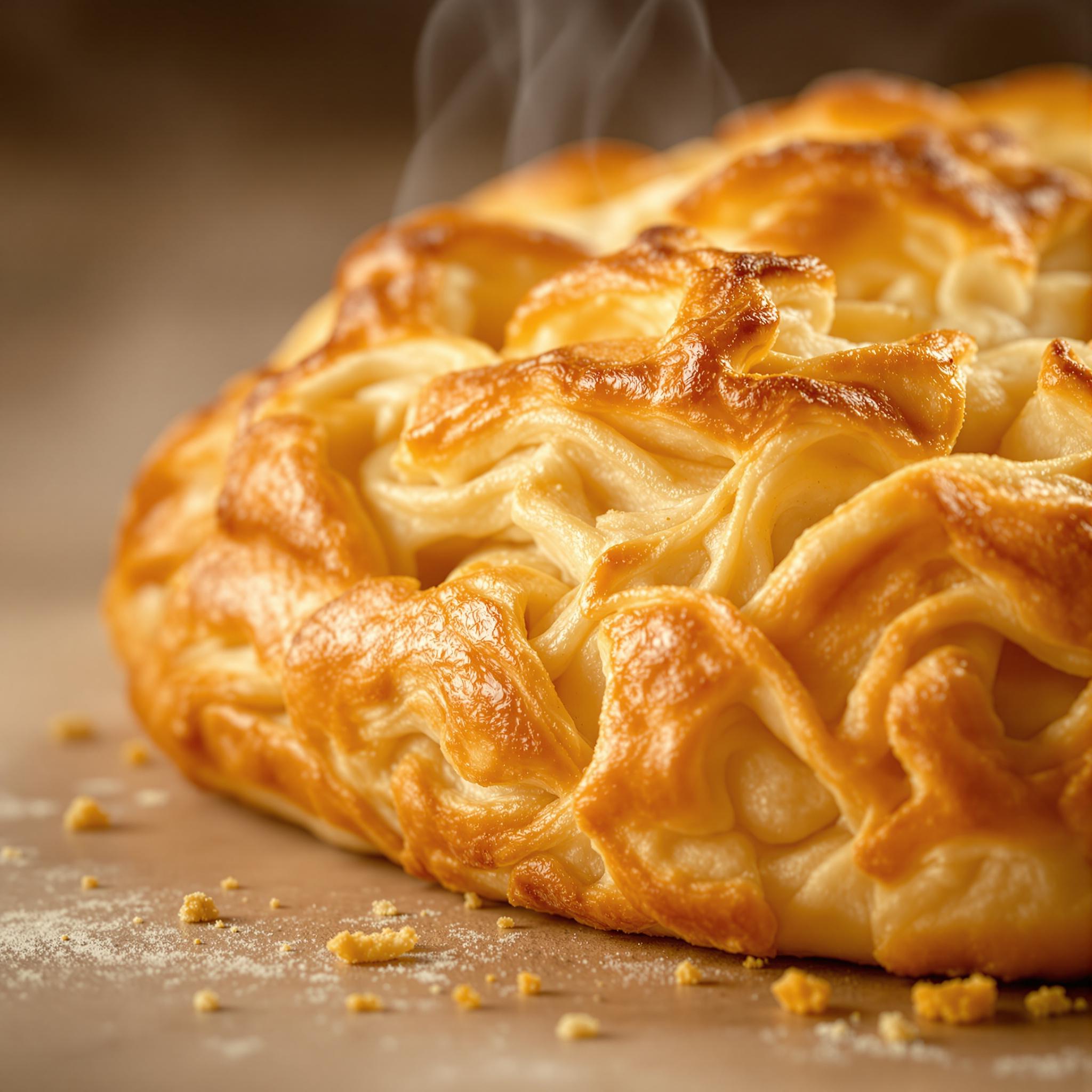Welcome to the World of Rough Puff Pastry: A Recipe You’ll Love
There’s something magical about creating flaky, buttery layers in your own kitchen. Today, we’re diving into the art of making Rough Puff Pastry, a simplified version of traditional puff pastry that delivers all the flavor and texture without the fuss. This recipe is special to me because it’s one I perfected during a cozy weekend baking session with my family. The aroma of butter and flour filled the air, and the end result? Golden, crispy perfection that everyone raved about. Whether you’re new to baking or a seasoned pro, this rough puff pastry recipe will quickly become a favorite.
The Story Behind Rough Puff Pastry
Puff pastry has a rich history dating back to the 17th century when French bakers mastered the technique of creating those iconic airy layers. While classic puff pastry requires hours of folding and chilling, rough puff pastry offers a more approachable alternative for home cooks. It’s perfect for busy days when you still want to impress with homemade baked goods. I first discovered this method while searching for a quicker way to make savory tarts for a dinner party. Since then, it’s been my go-to for everything from appetizers to desserts.
Why You’ll Fall in Love with This Rough Puff Pastry Recipe
What makes this rough puff pastry recipe stand out is its simplicity. Unlike traditional puff pastry, which can feel intimidating, this version uses fewer folds and less time in the fridge. Yet, the results are just as stunning—light, flaky layers that melt in your mouth. Plus, it’s incredibly versatile. Use it for sweet treats like fruit turnovers or savory delights like cheese straws. Trust me; once you try this recipe, you’ll wonder how you ever lived without it.
Perfect Occasions to Whip Up Some Rough Puff Pastry
This flaky puff pastry dough is ideal for so many occasions! Impress guests at brunch with mini quiches or wow them at dinner parties with elegant vol-au-vents. It’s also fantastic for holiday gatherings, where you can create festive appetizers or desserts. And let’s not forget lazy Sundays—there’s nothing better than baking up a batch of warm pastries to share with loved ones.
Ingredients for Your Rough Puff Pastry
- 2 cups all-purpose flour
- 1 teaspoon salt
- 1 cup unsalted butter, cold and diced
- 2/3 cup ice water
Substitution Options for Flexibility
If you’re looking to tweak this homemade puff pastry, here are some substitutions:
- Use whole wheat flour for a nuttier flavor.
- Swap vegan butter for a plant-based option.
- Add a splash of lemon juice to the water for extra tenderness.
Preparation: Let’s Get Baking!
Step 1: Mixing the Dough
To start, combine the flour and salt in a large mixing bowl. Add the cold, diced butter and use a pastry cutter or your fingers to work it into the flour until the mixture resembles coarse crumbs. This step is crucial for achieving those signature flaky layers. Imagine the butter melting into golden pools as the pastry bakes—that’s what creates the magic! Pro tip: Keep everything cold to ensure the butter doesn’t soften too much during handling.
Step 2: Adding the Water
Gradually add the ice water, one tablespoon at a time, mixing gently with a fork until the dough begins to come together. Be careful not to overwork the dough; it should hold together but still have a slightly crumbly texture. Think of it as coaxing the ingredients into harmony rather than forcing them. Once combined, shape the dough into a rectangle, wrap it in plastic wrap, and chill it for 30 minutes.
Step 3: Folding the Dough
After chilling, roll out the dough into a long rectangle on a lightly floured surface. Fold it into thirds like a letter, then rotate it 90 degrees and repeat the process. This folding technique is what gives rough puff pastry its beautiful layers. After each fold, return the dough to the fridge for another 20 minutes to keep the butter firm. Repeat this process two more times for maximum flakiness.
Step 4: Final Rest and Shaping
Once the final fold is complete, let the dough rest in the fridge for an additional 30 minutes. When ready, roll it out to your desired thickness and cut it into shapes for your chosen dish. Whether you’re making palmiers or savory pockets, the possibilities are endless. As you work, notice how the dough feels smooth yet sturdy under your hands—a sign that you’ve nailed the technique.
Chef’s Tip for Perfect Rough Puff Pastry
Here’s my secret: Always chill the dough between folds. Not only does this prevent the butter from melting prematurely, but it also relaxes the gluten, ensuring a tender final product. Patience is key!
Time Breakdown for Your Rough Puff Pastry
- Prep Time: 20 minutes
- Cooking Time: Varies by recipe (e.g., 20-25 minutes for turnovers)
- Resting Time: 2 hours total
- Total Time: Approximately 2 hours 40 minutes
Nutritional Information per Serving
- Calories: 250
- Protein: 4g
- Fat: 18g
- Carbohydrates: 20g
An Interesting Curiosity About Rough Puff Pastry
Did you know that puff pastry gets its rise purely from steam? As the water in the butter evaporates during baking, it creates pockets of air, resulting in those heavenly layers.
Necessary Tools for Success
- Rolling pin
- Pastry brush
- Sharp knife or pizza cutter
- Baking sheet
Storage Instructions for Your Rough Puff Pastry
Once baked, store your flaky puff pastry creations in an airtight container at room temperature for up to two days. For longer storage, freeze unbaked dough wrapped tightly in plastic wrap and aluminum foil for up to three months. To reheat, simply pop the pastries into a preheated oven at 350°F for 5-10 minutes until warmed through. If freezing baked goods, thaw them overnight in the fridge before reheating.
Tips and Tricks for Better Results
- Keep your workspace cool to maintain the integrity of the butter.
- Don’t skip the resting periods—they’re essential for layer formation.
- Use a bench scraper to lift and turn the dough while rolling to avoid sticking.
Serving Suggestions for Your Rough Puff Pastry
- Top with fresh berries and whipped cream for a dessert twist.
- Fill with ham and cheese for a savory snack.
Healthier Alternatives for Your Rough Puff Pastry
Looking to lighten things up? Here are six variations:
- Whole Grain Version: Substitute half the all-purpose flour with whole wheat flour for added fiber.
- Vegan Option: Use coconut oil instead of butter for a dairy-free treat.
- Low-Fat Twist: Reduce the butter by ¼ cup and replace it with Greek yogurt.
- Sugar-Free Dessert: Skip added sugars and pair with naturally sweet fruits like apples or pears.
- Gluten-Free Adaptation: Swap regular flour for a gluten-free blend designed for baking.
- Herb-Infused Savory Pastry: Add dried herbs like rosemary or thyme for a flavorful kick.
Common Mistakes to Avoid
Mistake 1: Overworking the Dough
Overworking the dough can lead to tough, chewy results instead of light and flaky layers. To avoid this, handle the dough as little as possible and stop mixing as soon as it comes together. Pro tip: Use a light touch and trust your instincts.
Mistake 2: Skipping Resting Times
Skipping resting times might seem like a time-saver, but it compromises the structure of your rough puff pastry. The dough needs these breaks to relax and allow the butter to firm up again. Stick to the schedule for best results.
Mistake 3: Using Warm Butter
Warm butter blends too easily into the flour, ruining the distinct layers you’re aiming for. Always start with cold butter and work quickly to keep it chilled throughout the process.
Frequently Asked Questions
Can I Make Rough Puff Pastry Ahead of Time?
Absolutely! You can prepare the dough up to three days in advance and store it in the fridge. Just make sure it’s well-wrapped to prevent drying out.
Is Rough Puff Pastry Gluten-Free?
Not traditionally, but you can adapt it using a gluten-free flour blend. Keep in mind that the texture may vary slightly.
How Do I Know When My Pastry Is Done?
Your homemade puff pastry is ready when it turns a deep golden brown and feels crisp to the touch. Underbaked pastry won’t have the same flaky texture.
Can I Freeze Rough Puff Pastry?
Yes, both raw and baked versions freeze beautifully. Wrap tightly to avoid freezer burn and label with the date.
What Can I Use Instead of Butter?
For a dairy-free option, try margarine or coconut oil. However, butter provides the richest flavor.
Why Are My Layers Not Flaky?
This could be due to skipping resting times or using warm butter. Follow the steps carefully for optimal results.
Can I Add Sugar to the Dough?
For sweet applications, adding 1-2 tablespoons of sugar enhances the flavor without affecting the texture.
How Thin Should I Roll Out the Dough?
Aim for about ¼ inch thickness for most recipes. Thicker dough may not cook evenly, while thinner dough risks tearing.
What Tools Do I Need?
A rolling pin, sharp knife, and baking sheet are essential. A pastry brush helps apply egg wash for a glossy finish.
Can I Use Rough Puff Pastry for Sweet Dishes?
Definitely! Fill it with fruit, chocolate, or custard for delightful desserts.
Conclusion
With this rough puff pastry recipe, you now have the power to create bakery-worthy treats right at home. Whether you’re crafting savory appetizers or indulgent desserts, this versatile dough will elevate your culinary repertoire. So grab your apron, gather your ingredients, and let’s bake something amazing together!

Equipment
- Mixing Bowl
- Rolling Pin
- Pastry Cutter
- Baking Sheet
Ingredients
- 2 cups all-purpose flour
- 1 tsp salt
- 1 cup unsalted butter cold and diced
- 2/3 cup ice water
Instructions
- Combine flour and salt. Add butter and mix until coarse crumbs form.
- Gradually add ice water, mixing gently until dough holds together. Shape into rectangle and chill.
- Roll and fold the dough, chill between each fold. Repeat several times for layers.
- Rest dough, then shape and cut as desired.


